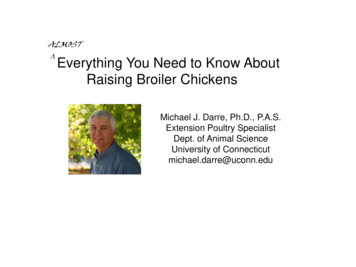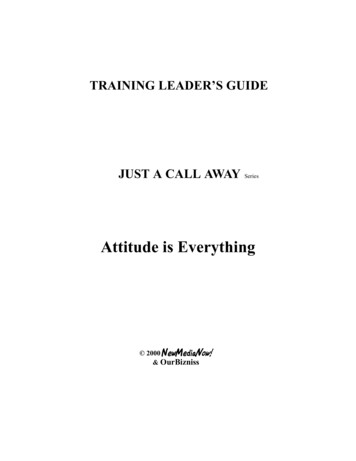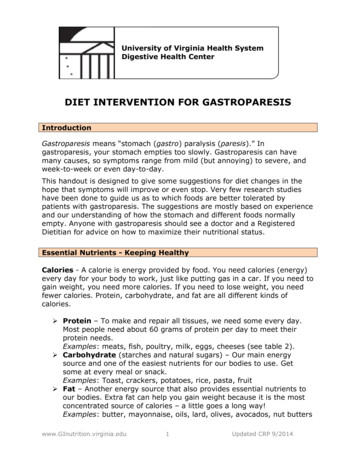
Transcription
ALMOSTΛEverything You Need to Know AboutRaising Broiler ChickensMichael J. Darre, Ph.D., P.A.S.Extension Poultry SpecialistDept. of Animal ScienceUniversity of Connecticutmichael.darre@uconn.edu
SMALL POULTRY FLOCK OWNER CHECKLISTSelecting the bird: Type of poultry: meat type – Cornish Cross , or other breed Purchase disease free stock (from NPIP source,Pullorum and AI free) Plan for all-in - all-out flocksBefore the birds arrive: Draft free coop or housing, cleaned and disinfected Brooder stove or heat lamp (red bulb type, if needed) set to 95oF forfirst week. Dry litter, (pine shavings preferred), 3-4 inches on clean floor. Roosts (use clean tree branches) 2-6” above ground for broilers Feeders and Waterers, cleaned and disinfected Fresh Feed, appropriate for age and type of bird
When the birds arrive: Check for symptoms such as coughing, sneezing, watery eyes, laboredbreathing, diarrhea, or pasty butt. Check for external parasites Provide water for first couple of hours, then add feed. (if birds havebeen shipped overnight, then make a 5% sugar water solution forfirst day) Check waters, feeders, heat source, eliminate drafts, etc. Wild bird and rodent proof coop, set bait stations, traps, etc., asneeded. Biosecurity - foot dips, clean shoes or boots, limit visitors and traffic,set up a quarantine area.
General Management: Check birds daily for signs of disease. If disease is suspected get a reliable diagnosis and treat as necessary. Cull very sick or injured birds, use proper disposal (burn or bury deep) Establish a regular de-worming program Keep litter clean and dry, replace wet litter. Do thorough clean out every sixmonths including disinfection. Proper disposal of manure such as composting.
Choosing Meat BreedsUnlike with layers, there are limited options – Cornish X– Other hybrid varieties (Reds, Barred, Silvers.etc)– Dual purpose varieties (Buffs, Barred Rocks)
Colored Feathered Birds – becoming more popularFreedom rangerJ.M. Hatchery178 Lowry Road, New Holland, PA 17557(717)336-4878
Here is what Troy Griepentrog wrote about the Freedom ranger: I spent about 229.11 buying the chicks and feed. I fed about 530 pounds of commercialfeed plus about 90 pounds of whole oats. The following numbers aren’tprecise, but should be pretty close:620 pounds of feed produced 195 pounds of live birds (3.17 pounds of feedper pound of gain — about the expected ratio).130 pounds of meat (about 1.76 per pound)
Red Broilers:The Label Rouge (France) birds grow to 2.25 kg in 12 weeks, whilethe fast-growing broilers (Cornish cross) reach the same weight in 6weeks. The carcass is generally more elongated and has a smallerbreast and larger legs than conventional carcasses. In addition,slower-growing breeds are more suitable to outdoor productionthan fast-growing broilers.
Mt-Di Poultry Farm and HatcheryOwner/ Operator: George DibertAddress: 131 Hen House LaneAltoona, PA 16602Phone: 814.942.7024Email: mtdifarm@atlanticbb.netRed RangerU.S. Pullorum – Typhoid CleanU.S. AI CleanNPIP No. 23-519Cornish Cross, Red Ranger, Rosambro
Rosambro Broilers (medium-growth).The Rosambro is a new breed also offeredby MT-DI Hatchery. Rosambro broilers aregrown to an age between eight and tenweeks old. This bird has many of thesame benefits as the Red Broiler withsomewhat faster growth than the RedBroiler (but slower that the CornishCross).
The Red Ranger Broiler is a very profitable broiler to raise because of itsstrong disease resistance. The Red Ranger broiler chickens havean excellent conformation of white and dark meat yields, a tendertexture with the flavor of a slow growing bird. The Red Rangerhas a dark red feathering with a few of the tail feathers being eitherwhite or black, yellow shanks, beak, and skin.
Cornish Cross Broilers (fast growth).Cornish Cross (also called Cornish Rock) is anextremely fast growing chicken that isprocessed between six and eight weeks.
Moyer’s Broiler/Roaster chicks (sometimes nicknamedCornish Giants) can be grown to a live weight of over 4 lbs. by 6weeks of age Or, to a roaster weight of 8-10 lbs. Live weights of4-5 lbs. can be achieved on close to 2 lbs. of feed per pound ofmeat. They have excellent conformation, plump, tender breastmeat and good skin texture.Moyer’s K-22 Red Broilers (Cockerels Only) is a hearty meatbird that has resistant genetics providing good textured,flavorful meat for the discriminating consumer. They areperfect for the pastured poultry producer. The K-22 is a slowergrowing bird than the cornish giant with the males growing to alive weight of 5 pounds at around 8 weeks.
Stromberg's Chicks and Game Birds100 York StreetP.O. Box 400Pine River, Mn 56474Phone:(218) 587-2222Toll Free:(800) 720-1134Fax:(218) 587-4230Red Broiler from Stromberg’s
The Noll family is working to make medium-growing genetics more widely available in NorthAmerica. Henry Noll offers a Silver Cross that grows to five pounds live weight in nine weeks.Noll’s Poultry FarmKleinfeltersville, PA 17039717-949-3560717-949-3722 FAXJoe Cebe, Sr. offers a Cebe Red and Cebe Black meat variety that grows to 5 pounds live weightin 9 to 10 weeks.Cebe FarmsP.O. Box 1404Ramona, CA 92065760-789-8221Matt John of Shady Lane Poultry Farm, Inc. is currently developing a new hatchery and plans tointroduce several alternative broiler lines during the next several years.Shady Lane Poultry Farm, Inc.520 Agawam RoadWinchester, KY 40391859-737-2636
Privett HatcheryPO Box 176 Portales, NM 88130Tel: 575-356-6425Toll Free: 1-877-PRIVETTinfo@privetthatchery.comPrivett Hatchery has a slow-growing white broilerthat can be treated just like a dual-purpose chicken.Breeds of Red or Gray Broilers specific for range rearing:Yankee Chicks, Inc/Hall Brothers HatcheryP.O. Box 1026Norwich, CT 06360860-608-1389860-889-6351 FAXContact: Jerry SrednickiOr Gormavian FarmsGary Proctor – 860-716-9064Other birds can be ordered from Morris Burr 860-455-9964
A more complete listing of hatcheriesthroughout the U.S. can be found atwww.aphis.usda.gov/vs/npip/ and atwww.poultryconnection.com/hatchery.html.examples of hatchery Web y.com/chicks.html—616-772-6514
Basic NeedsFresh FeedFresh WaterFresh AirLightDarknessThermal EnvironmentProtectionSpace
Feeding your birds
Poultry NutritionWhat are the needs of the bird?7 major nutrient classes CarbohydratesProteinFatVitaminsMineralsWaterOxygen
The chick requires:13 vitamins13-16 inorganic elements (minerals)13 Amino Acids1 Essential Fatty AcidSource of Energy
With the exception of water, these nutrients are provided by the ingredientsthat make-up the diet. Ingredients are classified as: Cereal Grains Animal Proteins Vegetables Proteins Vegetable Fats Animal Fats Micro Minerals Macro Minerals Vitamin Premixes
Some Feedstuffs that supply Amino Acids to the DietAnimal ProteinsVegetable ProteinsMicrobiological IngredientsSynthetic AAPurified AA or Proteins
Examples:Corn, which is low in lysineSoybean meal, which is low in methionineBy themselves neither corn nor soybean meal canprovide enough essential amino acids to maximizeperformance.But when the two are combined, they provideadequate amounts of the essential amino acids andare said to complement each other.
What about Carb’s and Fat?Supply Energy* - Needed for heat and movementCarb”sSugars Cereal Grains – Corn, Oats, Barley, Rice, etc.StarchesGumsEtc.*Chickens need about 1,300 to 1,500kcal/lb of energy daily!!1 calorie is the energy required to raise 1gm of water 1oC,From 14.5 to 15.5oC.1 kcal is 1000 calories.
Fats and OilsCorn Oil or other Vegetable OilsAnimal FatsNot really an essential nutrient,other than Linoleic acid (18:2 fatty acid).Animal fats – solid, relatively inexpensive.Problems with digestion by young birds.Vegetable oils - liquid, expensivePellet quality, dustiness of feed
Energyimportant because it governs feed intakehigh energy --- low feed intakelow energy --- high feed intakeSources of energy - everything in the diet other than minerals.Metabolizable energy (ME) Energy intake as feed minus energy appearing in urine and feces.
Feed EnergyDigestible E.Fecal E.Metabolizable E.Urinary Gaseous E.Net E.Heat E.Production E. Maintenance E
What about them Vitamins?With the exception of Vitamin C, Poultry Require all the vitamins!Vitamins act a catalysts for many reactions, and re required in smallquantities. They can occur as vitamins per se or as precursors(provitamins).Fat Soluable - A, D*, E, K*Poultry cannot use just any form of D, must be D3, cholcalciferol!Water Soluable: Thiamine (B1)Riboflavin (B2)Pyridoxine (B6)Cyanocobalamin (B12)Pantothenic AcidFolic AcidCholine**BiotinNiacin** very high requirement by poultry, unlike 4 footed animals,Very little is synthesized by the chick. Generous safetyfactor 2-10x requirement.Storage loss - time, temperature, humidity
Time for MineralsMacro agnesiumSulfurMicro mFluorineSeleniumMolybdenium
Broiler Starter FeedsThe objective of the starter/brooding period (0 to 10 days of age) is to establishgood appetite and achieve maximum early growth. The target is to achieve aseven-day body weight of 170 g or above. Broiler Starter should be given for tendays. The Starter represents a small proportion of the total feed cost and decisionson Starter formulation should be based on performance and profitability ratherthan cost.The digestible amino acid levels in the feed are important aspects and must beconsidered when purchasing feed. (See Table 1)In wheat-feeding areas the use of some maize may be beneficial.Total fat levels should be kept low ( 5%) and saturated fats should be avoided,especially in combination with wheat.
Broiler Grower FeedsBroiler Grower feed will normally be fed for 14 to 16 days.The transition from Starter feed to Grower feed will involve a change oftexture from crumbs to pellets.There is a continuing need for a good quality Grower feed to maximizeperformance.Broiler Finisher FeedsBroiler Finisher feeds account for the major cost of feeding and economicprinciples should be applied to the design of these feeds.Changes in body composition can be rapid during this period and excessivefat deposition and loss of breast meat yield need to be carefully considered.
Table 1.Nutrient Specifications for As-Hatched Broilers Grown to 4.4-5.5 lb liveweight.From Ross 308 mgmt guide 2007
Table 2, Examples of Broiler Diets.
Pasture ManagementAlfalfa is good, but the soils of New England are acid and require alot of lime and soil treatment. Ladino clover has been found to be aproductive plant of high palatability for poultry.Types of legumes and grasses for Pasture Forage:White and red clover or Ladino clover,Orchard grass,Kentucky blue grass,Perennial rye grass and,AlfalfaUniversity research shows that chickens get only 10-15% of drymatter for their diet from the pasture itself, and turkeys up to 30%,so supplementation with other feeds is important, such as corn, orwheat and soybean meal, and vitamins and minerals.http://www.free-rangepoultry.com/
Here are some mixtures from 1947, when pasture was at a peak.Keep pasture mowed to increase new growth of fresh plant.Example Pasture Mixtures: (per acre)1. 12 lbs of Kentucky Bluegrass6 lbs of perennial rye grass2 lbs of Ladino cloverFrom Cornell3. 8 lbs Kentucky Bluegrass8 lbs Timothy3 lbs Alsike clover2 lbs Ladino cloverFrom Univ. of Maryland2. 6 lbs of Kentucky bluegrass10 lbs of perennial ryegrass4 lbs of Canada bluegrass2 lbs of Redtop2 lbs of Ladino clover1 lb of White cloverFrom Penn State4. 2.5 lbs Ladino Clover5 lbs Domestic rye grass( seed with clover in the spring)6 lbs Kentucky bluegrass(Seed in fall)4 lbs timothy(2 lbs in the fall)
The mixture (table 4) was chosen to be representative of arobust pasture for poultry and is similar to those specified in theliterature.It proved to be hard wearing for meat birds during a wetsummer, and the birds were observed to eat it.Some herbs (rosemary (Rosmarinus officinalis), sage(Salvia officinalis), oregano (Origanum vulgare) and thyme(Thymus vulgaris)) have powerful antioxidant capabilitiesand moderate antimicrobial activities (Adams, 1999).It maybe desirable, therefore, to include herbs in the mix if sucha practice permitted a reduced reliance on the feeding ofsynthetic antioxidants, and if immune responses were to beenhanced.Symposium on ‘Nutrition of farm animals outdoors: Intake of nutrients from pasture by poultry. Andrew Walkerand Sue Gordon IN: Proceedings of the Nutrition Society (2003), 62, 253–256
Some Housing and Equipment SuggestionsDepends on type of rearing management:Conventional – enclosed mechanical ventilated facilityPasture Pens - Chicken tractors,etc.“Free Range” pasture - Basic shelter.
Chicken Tractor?Do I LookLike JohnDeere?
Free-Range Poultry EssentialsMaintain at least 150' between skidhouses and field perimeter fencing tominimize predation problems.Maintain at least 100' between eachskid house to maintain flock separation.Move skids ahead 50' to fresh pastureas necessary, generally every three tofour weeks or as needed to keep birdsout of mud. Usually. any time the birdshave trashed an area around the skidthat is larger 5 feet it is time for a move.Expect the birds to range about 40' outfrom each skid. 2008 Herman Beck-Chenoweth
Bottom Line:Keep birds in a DRY and DRAFT FREEEnvironment!!
Feeding and watering equipment
s/
Processing your birdsStunExsanguinate (bleed out)Scald (138 to 145o FDefeatherRemove head, neck and legs (below hock)EviscerateChillPackage
1Sources of information on raising ackyardchickens.com/coop.htmlForsham Cottage Arks; http://www.forshamcottagearks.co.ukHenhouses http://www.henhouses.co.uk s/index /http://www.free-rangepoultry.com/Some good Books and resources for poultry:Storey’s Guide to Raising Poultry - Leonard S. Mercia, Storey Books, Pownal, Vermont 05261 ISBN 1-58017-263-6A Guide to Raising Chickens - Gail Damerow Storey Books, Pownal, Vermont 05261ISBN 0-88266-897-8Feeding Poultry – The classic guide to poultry nutrition - G. F. Heuser. Norton Creek Press. ISBN 0-9721770-2-7Chicken Tractor – The permaculture guide to happy hens and healthy soil. Andy Lee and Pat Forman.Pastured Poultry Profits – Joel Salatin – ISBN0-9638109-0-1Profitable Poultry Management 23rd ed. 1958 Snyder, Rowoth, Scholes and Lee. , Beacon Milling Company, Cayuga,NY1Listing of materials does not imply endorsement of any author or materialcontained in the books or websites.
The . !Well you know!!
strong disease resistance. The Red Ranger broiler chickens have an excellent conformation of white and dark meat yields, a tender texture with the flavor of a slow growing bird. The Red Ranger has a dark red feathering with a few of the tail feathers be











